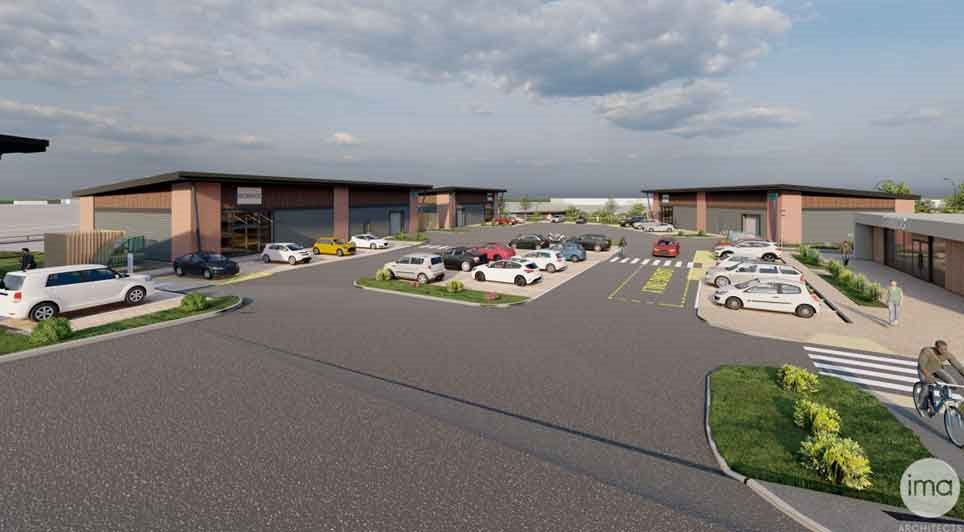When starting any structural project, choosing the right timber is key.
In this blog post, we delve into the properties, uses, and benefits of CLS timber as well as how it compares to our C16 and C24 regularised timber. From practicality to cost-effectiveness and even sustainability, discover why CLS timber could be the answer for your next project.
Knowing Your CLS Timber
In the construction world, CLS timber is a unique foundational timber. It has a set of characteristics that make it ideal for a wide array of projects, such as:
What does CLS stand for?
CLS timber actually gets its name from its origins in Canada. The material is an acronym for Canadian Lumber Standard timber and was originally devised as a means of benchmarking lumber used in residential construction in the country. However, it's relevant in various locations across the globe, as the Canadian Lumber Standard ensures that the timber meets exact dimensions, strength and quality requirements for a range of structural projects.
Physical Properties
So, what specific characteristics set CLS timber apart from other construction materials?
• Dimensions: CLS timber is typically available in two standard sizes - 38mm x 63mm and 38 x 89mm (though they may be labelled as 3x2 or 4x2 timber). This standardisation means that construction can proceed with a good deal of certainty, making for smoother workflows and more predictable outcomes.
• Strength: The material’s resilience is one of its most attractive characteristics. Typically graded to C16, indicating a significant bend strength, CLS timber promises to deliver secure support and strength in structures, offering guarantees that your buildings will be able to deal with a range of stresses and strains over many years.
• Durability: CLS timber’s longevity reveals itself through its resistance to wear and tear. It can offer security for structures over the long term with a minimal requirement for maintenance, making it a highly prudent investment for construction projects.
Is CLS Timber Treated?
Yes - our CLS timber is treated for resistance to pests, however it is not designed to withstand high levels of moisture, and is designed largely for indoor use. CLS that is used outside will need further treatment if it is to effectively withstand the elements.
Uses of CLS Timber
The versatility of CLS timber is among its most appealing features. It is a material that can find a place in numerous construction contexts, from structural walls to home DIY projects.
Residential Construction
CLS timber makes an ideal framing timber, which is why we see it in so many residential building projects. It provides the sturdy skeleton that makes up stud walls and partitions, door and window frames, and also sometimes in the process of battening roofing.
Commercial Projects
Due to it's structural nature and strength grading, CLS timber is similarly used in commercial construction such as office buildings, warehouses, and retail spaces, as it is conforms to British building standards and is a hard-wearing, reliable timber.
Landscaping and Outdoor Structures
Though CLS timber is typically used in interior projects, due to it's strength and smooth appearance, it can be used in outdoor projects, though it will almost certainly require further treatment to resist the effects of weather. In outdoor settings, it is sometimes used for decks, pergolas and raised garden beds, though a simpler alternative may be to use our treated timber.
Creative Uses
Beyond traditional construction, CLS timber is used in the world of DIY and design. Its reliable dimensions and smooth, planed surface make it a favourite of DIY enthusiasts for projects such as custom shelving and joinery.
Whether you're building a family home, commissioning a commercial space, or trying your hand at some DIY interior upgrades, its practicality is hard to beat.
Benefits of CLS Timber
So why choose CLS timber? From cost-effectiveness to environmental sustainability, let's explore the benefits that make CLS timber an excellent choice for professionals and DIY enthusiasts alike.
Cost-Effective
One of the most attractive things about CLS is its price point. It is an extremely cost-effective option when it comes to timber, providing superior value without sacrificing quality. Standardised sizes and ease of use also mean decreased labour costs, making CLS timber economical for a range of projects — from large-scale construction to small-scale DIY.
Environmental Sustainability
The environmental impact of building materials is a growing concern in today’s world, and CLS addresses this worry in a sophisticated fashion. In the UK, CLS timber is almost always sourced from FSC or PEFC forests. Its natural properties also make it an excellent insulator, which reduces the energy needed to heat and cool buildings. This provides an additional layer of appeal for the environmentally conscious.
Ease of Use
Whether you’re a pro or just starting out, CLS timber is easy to work with. It has predictable properties and uniform dimensions with smooth surfaces and eased corners, making it easy to handle, cut and install, resulting in time saved on construction projects and more precision and quality in the finished product.
Aesthetic Appeal
Though it's highly practical, CLS timber is not without its aesthetic virtues. Its warm tones and natural wood grain can add elegance and character to structures, enhancing their visual appeal.
Whether it is left exposed in architectural design or used as a structural element in construction, CLS timber can contribute significantly to a space, creating a look and atmosphere that are both appealing and inviting. With aesthetic and functional advantages, it is no surprise that CLS timber enjoys continual popularity for a variety of applications, decorative and otherwise.
CLS vs C16/C24 Timber
First off, it’s important to know how these timbers differ from each other and what makes CLS unique. Given their common use in structural projects, CLS timber is often compared to C16 and C24 timber. When planning a construction project, understanding the differences between them is essential.
C16/C24 Timber Overview
• C16 and C24 timbers are classified as strength grades. Timbers are graded based on their ability to hold certain loads so having a little knowledge of what the differences are between C16 and C24 will help you identify which one is going to be best suited for your project. Here’s what each of the timber is best used for and what their benefits are:
• C16: This grade is suitable for use in load-bearing projects such as residential framing and other small load-bearing structures. You’ll often hear that C16 is suitable for DIY projects and many smaller construction projects that require a relatively small load.
• C24: This is a much stronger alternative and is used primarily in heavier construction projects where there is a larger load requirement. You’ll often see this grade being used in commercial buildings as they bear a heavier load. It will primarily be used in projects such as roof trusses and floor joists, where its structural integrity is vital.
Strength and Structural Differences
As we have learned C16 and C24 timber are specialised products that are graded to a high strength grade, but are not always needed for simpler or less load-bearing projects. This is where the CLS timber comes in. CLS is often used as a general work timber as it can be used for a wide variety of construction jobs, though all of our CLS timber is graded to C16, and so is suitable for both lighter structural projects and as a general-use timber.
If you’re looking for timber that is better priced, strong, durable and low maintenance, CLS is what you are after. On the other hand, if you need a timber with a superior bend strength, you may need C24 timber joists.
Dimensions
Another notable difference between CLS and standard 3x2 and 4x2 timber is their dimensions. Though both types come in a similar choice of lengths, their cross-section dimensions are slightly different. In the UK, both types are traditionally referred to by imperial sizing - 4x2 or 3x2 - but in fact neither types measure exactly this measurement in millimetres.
Both C16/C24 timber and CLS timber is regularised, meaning it is planed to a smooth and even finish which results in a timber that measures a few mm smaller in both height and width. CLS is planed on all sides and means that is smaller again by a few millimetres - measuring typically 38x63mm or 38x89mm.
This difference is small, but can be an important distinction, so it is important to take note of when comparing the two.
Cost and Availability
Aside from the availability, the cost is also a consideration when choosing the right timber for your project. CLS is fairly widely available, which means the cost is typically very competitive, and it is easy to source. Though all of our timber is prices as competitively as possible, as only some timber is suitable to be graded to C16 and C24 timber, it is often less available and can come with a higher price tag, so if it is not necessary to a project, it can often make more sense to select C16 timber.
Tips for Choosing the Right Timber for Your Project
The success or failure of your construction project rests on the selection of the proper timber. Given the range of timber options for any given project, making the best choice can be confusing. Consider these tips for choosing the timber that will best meet the unique needs of your project, ensuring the longevity and quality of the final product.
Considerations
When selecting timber, several factors must be kept in mind such as:
• Project Requirements: Initially, take into account the structural and aesthetic demands of a project. Different timbers will offer varying levels of strength, durability and visual appeal, and because of this, it’s important to match the timber to the specifics of the project.
• Budget: Prices for timber can vary in cost significantly, so it’s key for any project to take into account the cost of materials. When going about selecting timber, determine how much you’re willing to spend, and then seek out the best value for that budget. We offer our best prices possible on all of our timber, so be sure to check out the selection.
• Sustainability: Green credentials are an increasingly relevant consideration for construction. Where possible, source timber from responsibly managed forests, and more generally, take into account the environmental impact of the selected material.
Maintenance and Care
Proper maintenance and care are instrumental in extending the life of any timber structure:
• Regular inspection will identify possible issues early, preventing minor problems from escalating into major repairs.
• Protective treatments, from sealants to preservatives, can strengthen the timber’s resistance to pests and weather, as well as prevent decay.
• Prompt repair is essential for maintaining the structural integrity of a timber and in preventing damage from spreading.
Conclusion
So which timber you should choose? Be it CLS, C16 or C24 it all depends on the needs of your project-- its budget, environmental footprint, and other small details, but hopefully you are now better placed to make that decision.
For high-quality timbers, consider DIY Building Supplies for a wide selection of CLS, C16 and C24 timber to suit a wide variety of project types.
diybuildingsupplies.co.uk
Construction News
22/04/2024
What Is CLS Timber, And Why You Should Use It For Your Next Project


25/04/2025
Aston Villa Football Club has unveiled plans to refurbish and expand the iconic North Stand at Villa Park, a major step in the wider regeneration of the North Grounds.
The redevelopment will raise the stadium's total capacity to over 50,000, with the North Stand alone increasing to more than 12,00

25/04/2025
Morgan Sindall Construction's Southern Home Counties team has officially handed over the newly completed Crawley Innovation Centre to Crawley Borough Council (CBC).
The transformation of the former TUI travel house into a cutting-edge innovation, economic and technology hub drew local leaders, busi

25/04/2025
Clowes Developments has confirmed that construction will soon commence on five new trade counter, warehouse and industrial units at Stud Brook Business Park in Castle Donington, following planning approval from North West Leicestershire District Council.
The new development, Plot 1, will feature fi

25/04/2025
A historic 18th-century landmark has been carefully restored as part of the major Garendon Park housing development in Loughborough.
The Grade II* listed Obelisk, located within the grounds of the former Garendon Hall estate, had endured years of weathering before undergoing a sensitive restoration

25/04/2025
Mace has appointed industry heavyweight, Gary Sweeney, to head up its European team working across the Healthcare, Life Sciences and Technology sectors.
Gary joins Mace following a spell as Interim Director in Turner & Townsend’s Advanced Manufacturing, Industrial and Logistics division in the UK

25/04/2025
A groundbreaking ceremony has recently marked the start of a £5.5 million extension project at Thorp Academy in Ryton, Gateshead.
The development, aimed at accommodating the growing student population, is being delivered by Morgan Sindall Construction on behalf of the Northern Education Trust (NET

25/04/2025
Wakefield-based Henley Stone Specialists has been appointed to deliver Glass Reinforced Concrete (GRC) elements for the first phase of 'Our Cultural Heart', Kirklees Council’s flagship project aimed at revitalising Huddersfield town centre.
Part of the Henley Construction Management Group, Henley S

25/04/2025
More than 2,500 Nottingham homes are set to benefit from energy efficiency improvements as part of a major £153 million regional initiative to cut household bills and carbon emissions.
Nottingham City Council's Executive Board has approved the acceptance of nearly £76 million in Government funding

25/04/2025
Introduction: What Is a Fitted Hoist?
A fitted hoist is a mechanical lifting device installed in the home to help safely move individuals with limited mobility. Commonly found in bedrooms, bathrooms and living spaces, these systems make it easier and safer to transfer someone between a bed, chair,

25/04/2025
Rail services between Hereford and Shrewsbury are facing significant disruption following the collapse of an underground culvert, forcing the closure of the line in both directions.
Emergency engineering works are underway to ensure the safety of the railway.
Network Rail's engineering teams are
 UK
UK Ireland
Ireland Scotland
Scotland London
London











